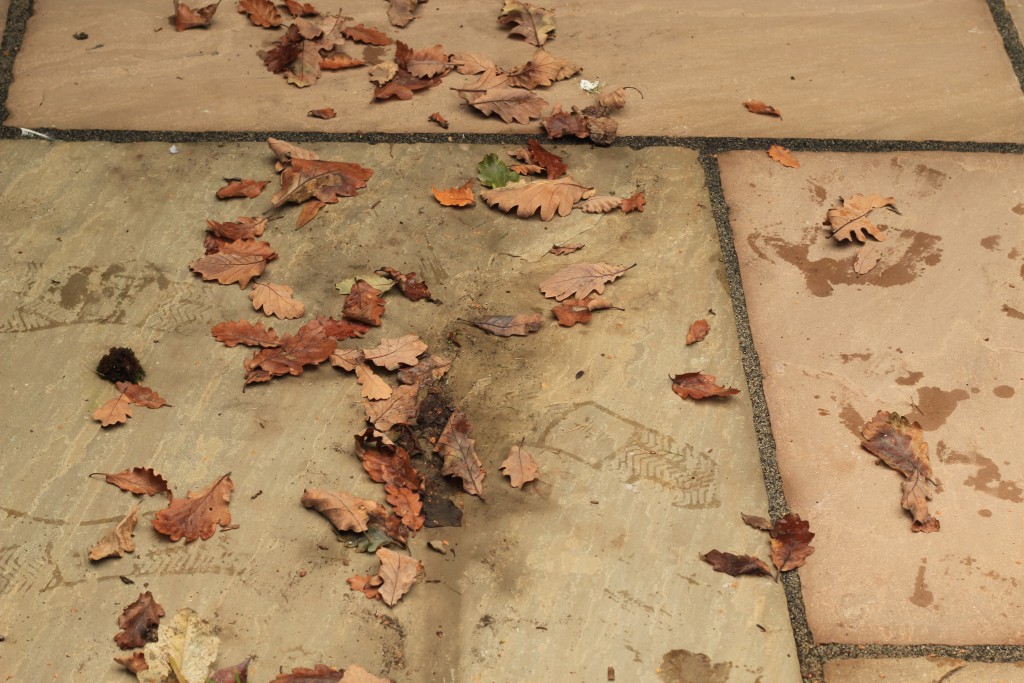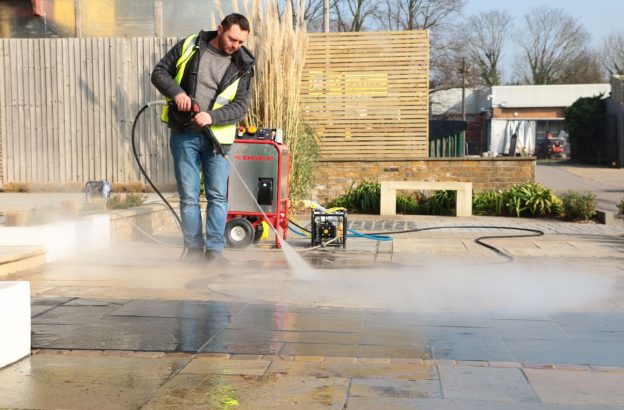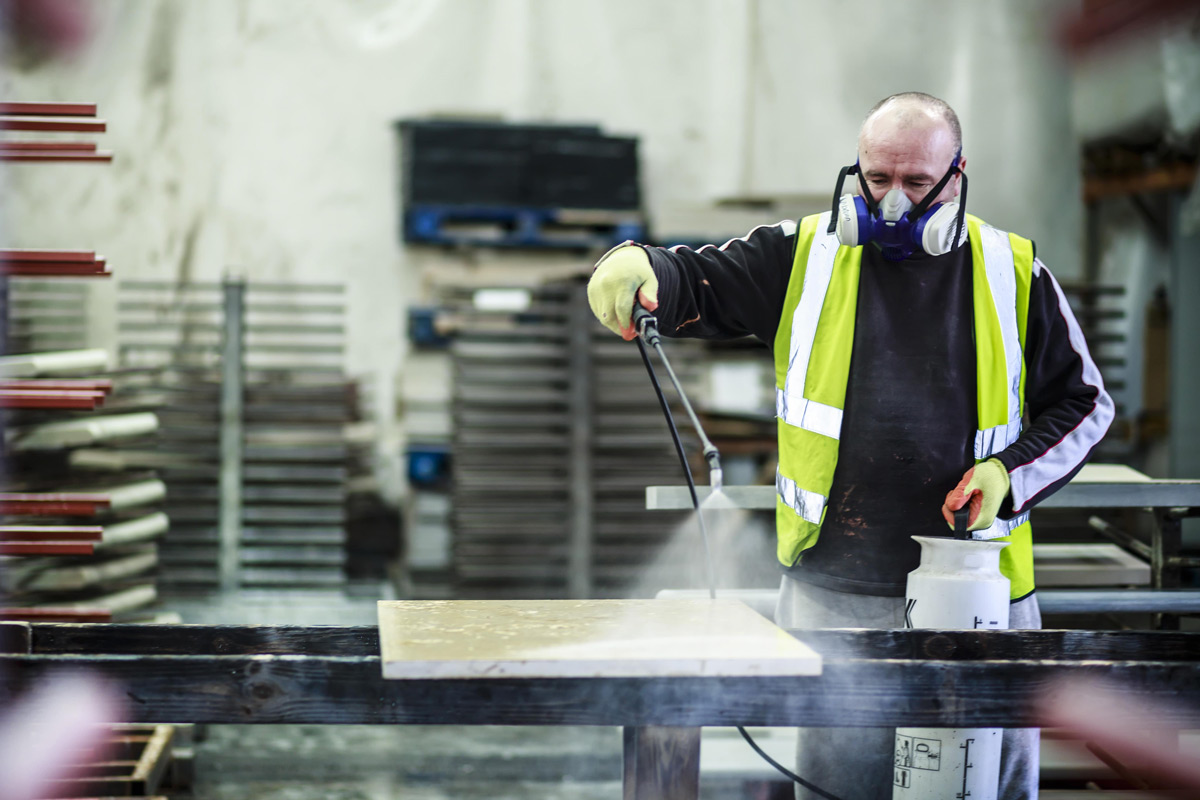One of the most important parts of patio construction is the pointing. This is when a perfectly laid patio can be ruined. We look at removing mortar stains from sandstone and other natural stone pavings.
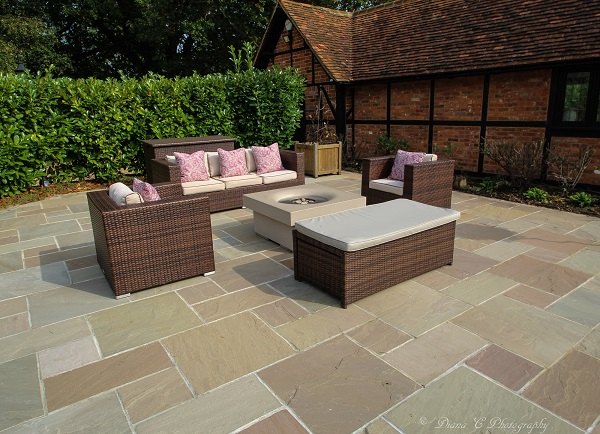
The importance of removing mortar stains
Let’s just think about how much time, effort and money goes into building a natural stone patio.
- Time and research in planning.
- Finding a reliable contractor.
- Excavating the area and installing a sub base.
- Paving the area.
- Finally, the patio needs to be pointed.
Point 5 seems like a small component in comparison, doesn’t it? But we’ve seen so many stone patios ruined by bad quality pointing.
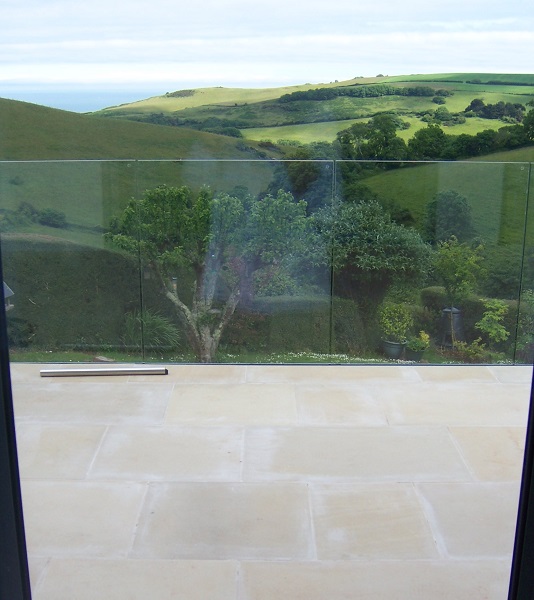
When it goes wrong
We had client in Devon who purchased Harvest sawn sandstone paving. The builder did a great job of the paving but, as you can see in the pictures, made a complete mess of the pointing.
He made two fundamental errors.
- He tried to install a gun-point mortar product with a trowel. This is a complete no-no because gun mortar products are designed to be installed…well, with a gun. The result was that the edges of the sandstone paving got covered in wet mortar.
- Even worse—and this happens with other pointing methods, too—the builder did not clean the mortar off properly.
Mortar spills are inevitable during any type of paving installation but they are easily solved by keeping a bucket of water and a sponge to hand and wiping off any spillages as you go.
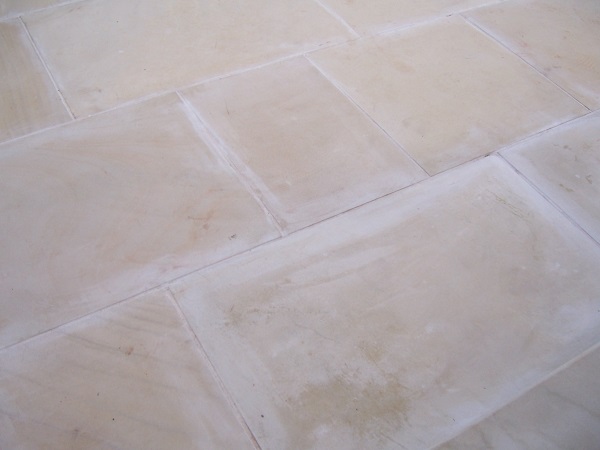
It was so frustrating because, clearly, a lot of thought had gone in to this patio and its looks were ruined simply because someone didn’t use a sponge and a bucket of water.
Luckily the problem is solvable, but obviously at a cost, and with lots of stress to the client.
How to clean mortar off paving slabs
Cleaning mortar off patio paving can create problems, rather than solve them. Using the wrong product can damage the surface of the slabs. It can also result in rust stains appearing, as the solution draws iron to the surface of the paving. While some paving has naturally occurring rust marks, it’s distressing when these arrive after you’ve chosen your stone for a different look.
How to remove fresh mortar
The ideal solution is to wipe mortar off with a cloth and some clean water immediately it’s spilled. Mortar should never be allowed to dry on the surface and should always be washed off thoroughly.
How to remove old mortar stains
Sometimes mortar stains have dried onto the stone. It looks a complete mess. Don't fear, as there is usually a way to remove them. It’s not easy and will require a significant amount of effort but, if you persevere, you will be able to remove the stains and restore your patio to its former beauty.
- If the mortar staining is very light it can be moved with a jet wash and a stiff brush. Take care, when jet washing, not to dislodge the mortar between the slabs.
- If the mortar residue is very ingrained into the surface of the stone paving, you’ll have to use a specialist paving cleaner to remove it. Drytreat Alkaline Cleaner (former name Oxy Klenza) is useful for removing grout and mortar stains. This should be your first port of call, because it’s an alkaline solution and kinder on natural stone paving.
- If Alkaline Cleaner does not work, the next stage is Lithofin Builders’ Clean. This is powerful product, so we recommend you understand the precautions you need to take with acid cleaners to ensure it works the way you want it to.
Note that, if you are cleaning mortar off limestone paving, acid-based cleaners should NEVER be used.
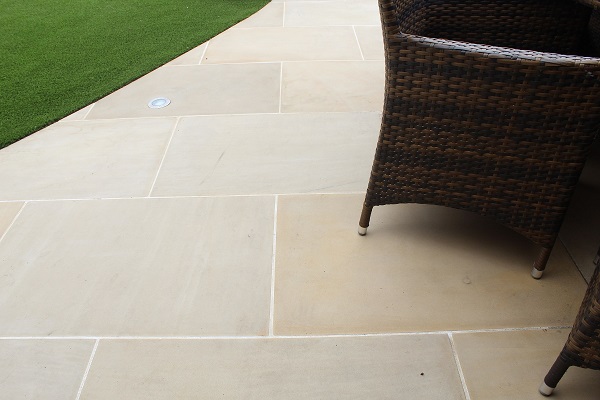
Use a proprietary cleaner
You’ll see brick acid bandied around the internet as a remedy. This can be an extremely strong solution of hydrochloric acid which, in inexperienced hands, can do extensive damage to paving. In contrast, for example, Builders’ Clean has been formulated to include rust-preventing agents.
Whatever you decide to use, we strongly recommend taking professional advice from a cleaning expert or your stone supplier, prior to using any kind of chemicals on natural stone paving.
To retain your patio's appearance for decades into the future, find out more about which patio cleaners to use.
Post updated: March 2023


/filters:quality(60)/mediadev/media/menu-pics/all-porcelain.jpg )
/filters:quality(60)/mediadev/media/menu-pics/luxury-italian.jpg )
/filters:quality(60)/mediadev/media/menu-pics/premium-italian.jpg )
/filters:quality(60)/mediadev/media/menu-pics/budget-porcelain.jpg )
/filters:quality(60)/mediadev/media/menu-pics/large-format-porcelain.jpg )
/filters:quality(60)/mediadev/media/menu-pics/wood-effect-porcelain.jpg )
/filters:quality(60)/mediadev/media/menu-pics/porcelain-planks.jpg )
/filters:quality(60)/mediadev/media/menu-pics/porcelain-setts.jpg )
/filters:quality(60)/mediadev/media/menu-pics/browse-all-paving.jpg )
/filters:quality(60)/mediadev/media/menu-pics/stone-paving.jpg )
/filters:quality(60)/mediadev/media/menu-pics/interior-tiles.jpg )
/filters:quality(60)/mediadev/media/menu-pics/stone-effect-porcelain.png )
/filters:quality(60)/mediadev/media/menu-pics/wood-effect-porcelain.png )
/filters:quality(60)/mediadev/media/menu-pics/grey-porcelain.png )
/filters:quality(60)/mediadev/media/menu-pics/beige-porcelain.png )
/filters:quality(60)/mediadev/media/menu-pics/dark-porcelain.png )
/filters:quality(60)/mediadev/media/menu-pics/light-porcelain.png )
/filters:quality(60)/mediadev/media/menu-pics/patio-grout.jpg)
/filters:quality(60)/mediadev/media/menu-pics/primers.jpg)
/filters:quality(60)/mediadev/media/menu-pics/porcelain-blades.jpg)
/filters:quality(90)/mediadev/media/menu-pics/drainage.jpg)
/filters:quality(60)/mediadev/media/menu-pics/cleaners.jpg)
/filters:quality(60)/mediadev/media/menu-pics/all-stone-paving.jpg )
/filters:quality(60)/mediadev/media/menu-pics/all-sawn-paving.jpg )
/filters:quality(60)/mediadev/media/menu-pics/all-riven-paving.jpg )
/filters:quality(60)/mediadev/media/menu-pics/indian-sandstone.jpg )
/filters:quality(60)/mediadev/media/menu-pics/limestone-paving.jpg )
/filters:quality(60)/mediadev/media/menu-pics/granite-paving.jpg )
/filters:quality(60)/mediadev/media/menu-pics/slate-paving.jpg )
/filters:quality(60)/mediadev/media/menu-pics/yorkstone-paving.jpg )
/filters:quality(60)/mediadev/media/menu-pics/stone-pavers.jpg )
/filters:quality(60)/mediadev/media/menu-pics/cobbles-setts.jpg )
/filters:quality(60)/mediadev/media/menu-pics/plank-paving.jpg )
/filters:quality(60)/mediadev/media/menu-pics/paving-circles.jpg )
/filters:quality(60)/mediadev/media/menu-pics/bespoke-paving-1.jpg )
/filters:quality(60)/mediadev/media/menu-pics/edging-stones-1.jpg )
/filters:quality(60)/mediadev/media/menu-pics/prestige-stone.jpg )
/filters:quality(60)/mediadev/media/menu-pics/grey-blue-stone.png)
/filters:quality(60)/mediadev/media/menu-pics/swatch-black-dark.jpg )
/filters:quality(60)/mediadev/media/menu-pics/swatch-buff-beige-white.jpg )
/filters:quality(60)/mediadev/media/menu-pics/sealants.jpg)
/filters:quality(60)/mediadev/media/menu-pics/all-clay-paving.jpg )
/filters:quality(60)/mediadev/media/menu-pics/alpha-clay-pavers.jpg )
/filters:quality(60)/mediadev/media/menu-pics/cottage-garden-clay-pavers.jpg )
/filters:quality(60)/mediadev/media/menu-pics/kessel-garden-clay-pavers.jpg )
/filters:quality(60)/mediadev/media/menu-pics/artisan-clay-pavers.jpg )
/filters:quality(60)/mediadev/media/menu-pics/grey-blue-clay-paver.png )
/filters:quality(60)/mediadev/media/menu-pics/red-brown-clay-pavers.png )
/filters:quality(60)/mediadev/media/menu-pics/beige-buff-clay-pavers.png )
/filters:quality(60)/mediadev/media/menu-pics/composite-decking.jpg )
/filters:quality(60)/mediadev/media/menu-pics/designboard-decking.jpg )
/filters:quality(60)/mediadev/media/menu-pics/classic-designboard.jpg )
/filters:quality(60)/mediadev/media/menu-pics/brushed-designboard.jpg )
/filters:quality(60)/mediadev/media/menu-pics/grooved-designboard.jpg )
/filters:quality(60)/mediadev/media/menu-pics/millboard-decking.jpg )
/filters:quality(60)/mediadev/media/menu-pics/grey-decking.jpg )
/filters:quality(60)/mediadev/media/menu-pics/black-charcoal-decking.jpg)
/filters:quality(60)/mediadev/media/menu-pics/brown-decking.jpg)
/filters:quality(60)/mediadev/media/menu-pics/all-build-deck.png )
/filters:quality(60)/mediadev/media/menu-pics/stone-cladding.jpg )
/filters:quality(60)/mediadev/media/menu-pics/all-garden-walling-1.jpg )
/filters:quality(60)/mediadev/media/menu-pics/facing-bricks.jpg )
/filters:quality(60)/mediadev/media/menu-pics/garden-screening.jpg )
/filters:quality(60)/mediadev/media/menu-pics/all-steps-coping.jpg )
/filters:quality(60)/mediadev/media/menu-pics/stone-garden-steps.jpg )
/filters:quality(60)/mediadev/media/menu-pics/sawn-steps.jpg )
/filters:quality(60)/mediadev/media/menu-pics/riven-steps.jpg )
/filters:quality(60)/mediadev/media/menu-pics/yorkstone-steps.jpg )
/filters:quality(60)/mediadev/media/menu-pics/bespoke-steps.jpg )
/filters:quality(60)/mediadev/media/menu-pics/porcelain-steps.jpg )
/filters:quality(60)/mediadev/media/menu-pics/off-the-shelf.jpg )
/filters:quality(60)/mediadev/media/menu-pics/stone-coping.jpg )
/filters:quality(60)/mediadev/media/menu-pics/sawn-coping.jpg )
/filters:quality(60)/mediadev/media/menu-pics/riven-coping.jpg )
/filters:quality(60)/mediadev/media/menu-pics/yorkstone-coping.jpg )
/filters:quality(60)/mediadev/media/menu-pics/bespoke-coping.jpg )
/filters:quality(60)/mediadev/media/menu-pics/stone-pier-caps.jpg )
/filters:quality(60)/mediadev/media/menu-pics/porcelain-coping.jpg )
/filters:quality(60)/mediadev/media/menu-pics/all-bespoke-services.jpg )
/filters:quality(60)/mediadev/media/menu-pics/bespoke-paving-2.jpg )
/filters:quality(60)/mediadev/media/menu-pics/bespoke-steps-1.jpg )
/filters:quality(60)/mediadev/media/menu-pics/bespoke-coping-1.jpg )
/filters:quality(60)/mediadev/media/menu-pics/edge-profiles.jpg )
/filters:quality(60)/mediadev/media/menu-pics/masonry-services.jpg )
/filters:quality(60)/mediadev/media/menu-pics/deluxe-pergolas.jpg )
/filters:quality(60)/mediadev/media/menu-pics/proteus-pergolas.jpg )


